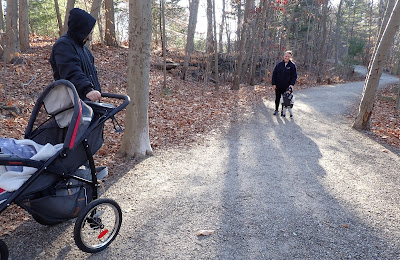Fall & Winter are a good times to fix busted tools. A while back one of our old bow front rake heads was pulled from the land of broken toys box. The handle was broken off just below the ferrule, and it seemed to ask if we should just junk this or what.
The old bow head rake, after cleaning. It looked like it had potential. This may have been a donation, or a
pick up at the dump.
I looked a little closer and remembered that this was an old rake
that was fixed up in the past by Rick Swanson. This had been repaired once before when the rake head bow had rusted
out. Rick had fixed that by welding the head to the ferrule and it was jammed back on the old handle and put back into service. That old handle finally gave up the
ghost a couple of years ago, and left us with another repair.

So, next steps were to cut off the remains of the broken handle, grind
off one head of the rivet holding the head to the handle stump, knock
out the
old rivet (using a punch or nail), wire brushing the rusty rake head, clean out the remains of
the old wooden handle from the socket, and gave it a little Rustoleum
love.
In the early
years of the Shelton Trails Committee we got a lot of tools through donations, dump finds, or
neighborhood tag sales. We're still cheap Yankees
whenever we can.

Fuzzy picture of the cleaned-out-ferrule.
Helpful Trail Tip: A masonry drill bit works well to take out the old handle without getting the a wood drill bit dulled up inside of the metal ferrule.
Next: Getting and shaping the handle.
1. Skip Home Depot or Lowe's, and find an ACE Hardware store, or something similar, to get a replacement handle. The pickings for a quality ash handle are much better at a small hardware store that caters to contractors. Be fussy, get the grain to go perpendicular to the handle with no weird curves. It will make the handle stronger in the future when volunteers beat on it.
2. Shape the end of the handle to match the ferrule. Do a trial and error pushing the handle into the ferrule and twisting it to see where it rubs.
3, In this case we used a spoke shave and rasp to shape the handle end. You can also use sandpaper or a file depending on what you have available. Use whatever you have to do the job. Just take your time and do not rush it. Try to avoid a sloppy fit. It'll make for a stronger rake in the long run.
After getting everything so it was a tight fit, we added a little epoxy and banged everything together. Next day, we drilled out a hole through the handle for the new rivet, held the replacement shovel rivet in pliers, heated the end up red hot with a propane torch, shoved the rivet through the handle, placed the rake ferrule on a vise to act as an anvil, and formed a tight domed rivet with a ball peen hammer. Lots of repeated hammer blows to shape the rivet head.
Shovel rivets are tough to come by these days. Some are attached to replacement handles in the store, but you often have to scrounge for them. In a pinch use a large nail, cut it off a bit above the ferrule, heat it with a torch and then bang it into a tight dome with a ball peen hammer.
Historical Rake Note: Rick and Madeline Swanson were great neighbors. Rick worked on cars and was a true artist when it came to body work and painting. He was also a good neighbor (and so was Madeline), I think he worked on every car our family ever had. The nice part about having the village blacksmith living next door was that he welded up all our busted tools; pitchforks, shovels, rakes, it didn't matter. And he never wanted anything for it. He was just being nice to his neighbors and helping out Shelton's trails.
Here's Rick on left and Madeline on right, talking to Bert and Nancy in the middle; our fiends and trail volunteers, at a picnic that we had in 2005. I'm going to go out on a limb and guess that Rick and Bert were talking about cars (both are big-time car guys). I'm constantly amazed how very lucky we are to have so many handy, talented, and hardworking people willing to help out with trails and open space in Shelton.
Sometimes you fix up old tools because you don't have money to buy new stuff. Sometimes you fix up old tools because they're better made, and it's cheaper to fix them up than to buy the stuff sold in the stores today. And sometimes because it brings a smile remembering old friends who helped you out in the past.
We gave everything some black spray paint, and added some orange duct tape with S.T.C. to the handles so we could find the rake in the woods. The old, newly fixed up rake is ready to go. It may not be as quick or easy as running out to the store to buy a new rake, but we do try to save the Shelton taxpayer's money where we can. It only cost about $12 bucks for the handle. Another tool is now ready to get dirty on Shelton's trails in 2023.



.jpg)
.jpg)




























.jpg)
.jpg)





.jpg)



.jpg)













